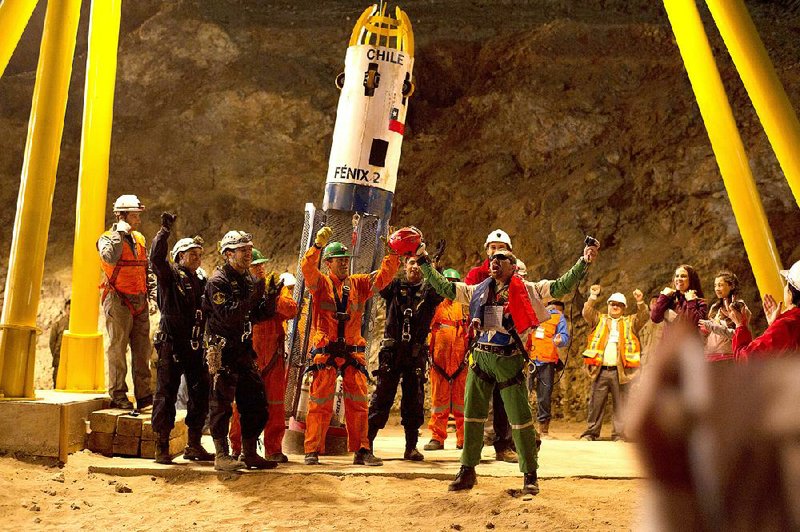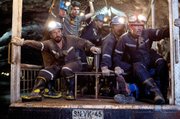Harrowing, suspenseful, pitting hope against despair and culminating in a triumph of can-do spirit -- the story of the 2010 collapse of a century-old Chilean mine is, for good and bad, the stuff of Hollywood dreams. Director Patricia Riggen finds a rigorous and affecting visual language for The 33, but she and her international cast are hampered by a screenplay that too often gets in the way of a powerful story.
As it counts down the trapped miners' two-month ordeal, the film sticks to the formulaic surface, moving among an assemblage of neatly summarized types rather than full-blooded characters. But given how widely watched the real-life events were, the movie arrives with a must-see factor that will serve it well at the box office, at least initially.
The 33
83 Cast: Antonio Banderas, Rodrigo Santoro, Juliette Binoche, Lou Diamond Phillips, Gabriel Byrne, James Brolin, Mario Casas, Jacob Vargas, Juan Pablo Raba, Bob Gunton
Director: Patricia Riggen
Rating: PG-13, for a disaster sequence and some language
Running time: 127 minutes
In light of the increasing commercial clout of Spanish-language films, the decision to shoot the movie in English is disappointing. It's also highly distracting, with an international cast juggling a collection of Spanish accents.
They include Antonio Banderas as Mario Sepulveda, the men's de facto leader, all action and hope when shift supervisor Don Lucho voices caution and fatalism. Lou Diamond Phillips plays the latter as a man long caught in the middle, determined to protect his men in an ill-maintained mine but feeling powerless in the face of negligent owners. The economic and political aspects of the story are touched upon only glancingly as the screenplay, credited to Mikko Alanne, Craig Borten (Dallas Buyers Club) and Michael Thomas, puts emotions front and center. The late James Horner's score helps to push the emotional buttons while leaning way too heavily on Andean folk instrumentation.
The heart-tugging story strands unwind in the depths of the mine and above ground, where the miners' families set up a makeshift city and Laurence Golborne (Rodrigo Santoro), Chile's young, green minister of mining, oversees the rescue efforts of a team led by chief engineer Andre Sougarret (Gabriel Byrne), with James Brolin making a cameo appearance as an American drilling expert.
Among the more distracting elements of the film is Juliette Binoche's turn as Maria Segovia, a hawker of empanadas whose troubled brother (Juan Pablo Raba) is one of the 33. Her character's forthright defiance when Golborne shows up feels as forced as the bond they finally forge, not because the actors' performances aren't heartfelt but because their interactions are such transparent plot engines -- one of which leads to an utterly unpersuasive aha moment in the rescue strategy.
As for the title characters, most are sidelined, as would be expected in such a narrative feature. Ten miners get "storylines," such as they are, some of them screen-written composites like Raba's angry alcoholic, who will undergo the DTs, repentance and redemption. There's a young father-to-be (Mario Casas); an unlikely and comical philanderer (Oscar Nunez, of The Office); an old-timer with rattling lungs (Gustavo Angarita) who's on his final shift before retirement; and an ostracized Bolivian newcomer (Tenoch Huerta).
But mainly it's Super Mario and the 32 as Banderas' character, a natural leader, rations meager food supplies among 33 starving men trapped beneath 700 tons of rock. Mario's role in the men's survival could not be more crucial; more than doling out canned tuna, he quells any violent or self-destructive impulses that arise. But his selflessness takes up a lot of space. Made with the cooperation of the miners and based on the book that tells their authorized story, the film somewhat surprisingly follows the news-media template that turned Mario into a star. Phillips' intriguing Don Lucho, in particular, could have used more screen time, though the movie's final, potent image belongs to him.
At its best, the dialogue is gracefully pared down, but frequently it lapses into awkward exposition. To counteract this, Riggen smartly uses actual TV news footage, from a wide array of international sources, to explain the rescue mission and to convey how closely a worldwide audience was following the events in Chile.
The movie's narrative letdowns are especially unfortunate when Riggen, advancing her visual style significantly from previous work (Under the Same Moon, Girl in Progress), creates such a strong sense of place, both in the cramped quarters of the mine and the expansive desert where the families keep vigil. Shooting in two working mines in Colombia, the director and her cinematographer, Checco Varese, deliver an immersive sense of what it means to enter the tunnel on a road that burrows 2,300 feet beneath the surface. There's an obvious but nonetheless deeply affecting spiritual cast to the play of light in the dark cave, the miner's helmet torches illuminating the skyscraper-size rock that seemingly has sealed their fate.
As for the mine collapse itself, Riggen and Varese capture the enormity of the accident and the ensuing chaos with dynamic work that entails a strong, fluently integrated CGI assist. A shot of the explosion breaking through the placid surface of Chile's Atacama Desert -- the filmmakers used locations not far from where the disaster took place -- is exquisite in its terrible poignancy. The superb sound design lends further dimension, not just during the collapse but in the hope-stirring rumbling of the rescuers' drills trying to reach the men through the rock.
Riggen takes a chance with a fantasy sequence in which the men imagine that the women they love are serving them delectable meals. Though it's flagrantly over-the-top, it somehow feels just right. And it makes you wish that Riggen had taken more such risks rather than following the road-to-uplift formula so dutifully.
MovieStyle on 11/13/2015

